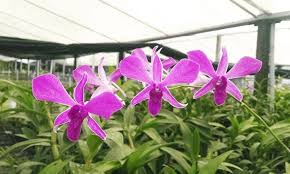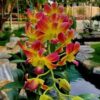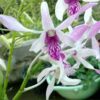# Creating Ideal Conditions for Dendrobium Orchids: Essential Tips and Guidelines

Dendrobium orchids are among the most popular and diverse types of orchids, known for their stunning blooms and elegant forms. For those passionate about cultivating these beautiful plants, understanding the ideal growing conditions is crucial for ensuring their health and vitality. This comprehensive guide will explore the essential factors for creating the perfect environment for Dendrobium orchids, from light and temperature to humidity and watering.
## Table of Contents
1. **Introduction to Dendrobium Orchids**
– 1.1 Characteristics of Dendrobium Orchids
– 1.2 Importance of Ideal Growing Conditions
2. **Understanding the Natural Habitat**
– 2.1 Native Environments of Dendrobium Orchids
– 2.2 Key Features of Their Natural Habitat
3. **Light Requirements**
– 3.1 Optimal Light Levels
– 3.2 Signs of Inadequate or Excessive Light
– 3.3 Best Lighting Solutions for Home Growers
4. **Temperature Control**
– 4.1 Ideal Temperature Range
– 4.2 Seasonal Temperature Variations
– 4.3 Strategies for Maintaining Optimal Temperature
5. **Humidity Levels**
– 5.1 Importance of Humidity for Dendrobiums
– 5.2 Ideal Humidity Levels
– 5.3 Ways to Increase Humidity
6. **Watering Techniques**
– 6.1 Watering Frequency and Amount
– 6.2 Signs of Overwatering and Underwatering
– 6.3 Best Practices for Watering Dendrobiums
7. **Choosing the Right Potting Medium**
– 7.1 Importance of Potting Mix for Orchids
– 7.2 Recommended Potting Mixes for Dendrobiums
– 7.3 Repotting Techniques and Timing
8. **Fertilization Guidelines**
– 8.1 Nutrient Needs of Dendrobium Orchids
– 8.2 Types of Fertilizers to Use
– 8.3 Fertilization Schedule
9. **Pest and Disease Management**
– 9.1 Common Pests Affecting Dendrobiums
– 9.2 Signs of Disease in Orchids
– 9.3 Prevention and Treatment Strategies
10. **Creating the Ideal Environment**
– 10.1 Indoor vs. Outdoor Growing
– 10.2 Greenhouse Conditions
– 10.3 Designing an Orchid Growing Space
11. **Conclusion**
– 11.1 Recap of Key Points
– 11.2 Encouragement for Orchid Enthusiasts
—
## 1. Introduction to Dendrobium Orchids
### 1.1 Characteristics of Dendrobium Orchids
Dendrobium orchids are part of a large genus that includes over 1,800 species, characterized by their diverse shapes, sizes, and colors. They are native to various regions, particularly Asia, and are known for their long-lasting flowers, which can bloom in a variety of hues, including white, yellow, pink, and purple.
### 1.2 Importance of Ideal Growing Conditions
To thrive, Dendrobium orchids require specific environmental conditions that mimic their natural habitat. Creating an ideal environment not only enhances their growth but also promotes vibrant blooms and longevity.
## 2. Understanding the Natural Habitat
### 2.1 Native Environments of Dendrobium Orchids
Dendrobium orchids are typically found in tropical and subtropical regions, growing on trees or rocks in rainforests, where they benefit from filtered sunlight and high humidity. Understanding these natural conditions is vital for replicating them in cultivation.
### 2.2 Key Features of Their Natural Habitat
In their native habitats, Dendrobium orchids experience warm temperatures, high humidity, and consistent moisture levels. The interplay of light, temperature, and moisture forms the foundation of their growth requirements.
## 3. Light Requirements
### 3.1 Optimal Light Levels
Dendrobium orchids thrive in bright, indirect light. Ideally, they need around 50-70% shade to prevent leaf burn while promoting healthy growth. South or east-facing windows are often the best locations for these plants.
### 3.2 Signs of Inadequate or Excessive Light
– **Inadequate Light**: If the leaves turn dark green and the plant grows leggy, it may be a sign of insufficient light.
– **Excessive Light**: Yellowing leaves or burnt leaf edges indicate that the plant is receiving too much light.
### 3.3 Best Lighting Solutions for Home Growers
For growers without adequate natural light, using grow lights can be an effective solution. Full-spectrum LED grow lights are particularly beneficial, providing the necessary wavelengths for photosynthesis while keeping energy costs low.
## 4. Temperature Control
### 4.1 Ideal Temperature Range
Dendrobium orchids prefer a temperature range of 65-85°F (18-29°C) during the day and slightly cooler temperatures at night (55-65°F or 13-18°C).
### 4.2 Seasonal Temperature Variations
These orchids can tolerate slight fluctuations in temperature, but extreme changes should be avoided. In winter, ensure that nighttime temperatures do not drop below 50°F (10°C) to prevent stress on the plant.
### 4.3 Strategies for Maintaining Optimal Temperature
– **Indoor Heating**: Use heaters to maintain warmth during colder months, but avoid direct exposure to heat sources.
– **Ventilation**: Good air circulation helps regulate temperature and humidity levels, preventing overheating.
## 5. Humidity Levels
### 5.1 Importance of Humidity for Dendrobiums
High humidity levels are crucial for Dendrobium orchids, as they absorb moisture through their leaves and roots.
### 5.2 Ideal Humidity Levels
The ideal humidity range for Dendrobiums is between 50-70%. Maintaining humidity within this range promotes healthy growth and vibrant blooms.
### 5.3 Ways to Increase Humidity
– **Humidity Trays**: Place water-filled trays with pebbles under the pots to increase humidity around the plants.
– **Misting**: Lightly misting the orchids with water can temporarily raise humidity levels, but be cautious not to overdo it, as excessive moisture can lead to fungal issues.
## 6. Watering Techniques
### 6.1 Watering Frequency and Amount
Dendrobium orchids prefer to dry out slightly between waterings. Depending on the environment, watering every 7-10 days is typically sufficient.
### 6.2 Signs of Overwatering and Underwatering
– **Overwatering**: Yellowing leaves and root rot are common signs of overwatering. The roots may appear mushy or dark brown.
– **Underwatering**: If the leaves become shriveled or wrinkled, the plant may need more water.
### 6.3 Best Practices for Watering Dendrobiums
– **Watering Technique**: Water thoroughly until excess water drains from the bottom of the pot, ensuring that the roots are well-hydrated.
– **Water Quality**: Use distilled or rainwater if possible, as tap water can contain chemicals harmful to orchids.
## 7. Choosing the Right Potting Medium
### 7.1 Importance of Potting Mix for Orchids
The potting medium is critical for providing proper aeration, drainage, and moisture retention for Dendrobium orchids.
### 7.2 Recommended Potting Mixes for Dendrobiums
A mix of bark, perlite, and sphagnum moss is ideal for Dendrobium orchids, allowing for excellent drainage while retaining moisture.
### 7.3 Repotting Techniques and Timing
– **Repotting Frequency**: Dendrobium orchids typically need repotting every 1-2 years, or when the potting medium breaks down.
– **Timing**: The best time to repot is during active growth, usually in the spring or early summer.
## 8. Fertilization Guidelines
### 8.1 Nutrient Needs of Dendrobium Orchids
Dendrobiums require balanced nutrients to thrive, particularly during their growing season.
### 8.2 Types of Fertilizers to Use
A balanced, water-soluble fertilizer (20-20-20) is ideal, diluted to half strength. Fertilizers high in potassium are beneficial during the blooming phase to enhance flower production.
### 8.3 Fertilization Schedule
– **Growing Season**: Fertilize every two weeks during the growing season (spring and summer).
– **Dormant Season**: Reduce fertilization to once a month during the dormant season (fall and winter).
## 9. Pest and Disease Management
### 9.1 Common Pests Affecting Dendrobiums
Dendrobium orchids can be susceptible to pests such as aphids, spider mites, and mealybugs. Regular inspection is crucial for early detection.
### 9.2 Signs of Disease in Orchids
Common signs of disease include discolored or wilting leaves, unusual spots, or a sticky residue on the plant.
### 9.3 Prevention and Treatment Strategies
– **Regular Monitoring**: Inspect plants weekly for pests and diseases.
– **Organic Treatments**: Use insecticidal soap or neem oil for pest control, and remove any diseased parts of the plant immediately.
## 10. Creating the Ideal Environment
### 10.1 Indoor vs. Outdoor Growing
Dendrobiums can be grown indoors or outdoors, but each environment has unique considerations.
– **Indoor Growing**: Ensure adequate light and humidity indoors; consider grow
lights if necessary.
– **Outdoor Growing**: Provide partial shade and protection from strong winds or heavy rains.
### 10.2 Greenhouse Conditions
Greenhouses can provide a controlled environment, allowing for optimal temperature, humidity, and light levels. Installing fans and misters can help maintain ideal conditions.
### 10.3 Designing an Orchid Growing Space
Create a dedicated orchid space that allows for proper air circulation, light access, and easy maintenance. Use shelves or hanging systems to maximize space and visibility.
## 11. Conclusion
### 11.1 Recap of Key Points
Creating ideal conditions for Dendrobium orchids involves careful attention to light, temperature, humidity, watering, potting mix, fertilization, and pest management. Each factor plays a crucial role in the overall health and blooming success of these beautiful plants.
### 11.2 Encouragement for Orchid Enthusiasts
By understanding and implementing these guidelines, both novice and experienced orchid enthusiasts can cultivate stunning Dendrobium orchids. With patience and care, your efforts will reward you with vibrant blooms and a thriving collection of these exquisite flowers.
—

